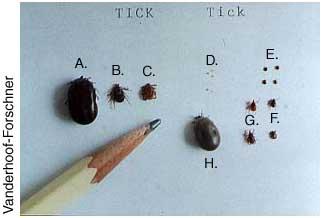TICKS, FLEAS & MOSQUITOES
Technically members of the arachnid class, (like spiders), ticks have 8 legs and multiple life stages wishing for a blood meal on a passing mammal or bird. Their habit of feeding, maturing, feeding, molting, and feeding again makes them excellent disease vectors.
Adult tick activity is at a peak in fall and early winter. Coincidentally, adult ticks are most likely to transmit disease. Protect yourself and your pets while out and about in the woods this season.
Here's a good picture to help differentiate between deer ticks and dog ticks.
The pencil gives a good sense of scale and both deer ticks and dog ticks are in the same shot
 Brown Dog Ticks Deer Ticks
Brown Dog Ticks Deer Ticks A. Engorged Female D. Larvae
B. Female E. Nymphs
C. Male F. Males
G. Females
H. Engorged Female
Fleas are another blood thirsty pest, many detailed technical resources exist. Suffice to say one female flea can produce approximately three gazillion baby fleas, all of them hungry and none too discriminating about who they feast on. Rodent fleas were a significant contributing factor in the spread of bubonic plague in 14th century Europe, killing an estimated 25 million people.
Mosquitoes, often referred to as the state bird of Michigan, are a plague unto themselves for people and pets.
In addition to a significant "ick" factor, ticks, fleas and mosquitoes are responsible for transmitting a variety of diseases and blood parasites to a variety of animals, humans included. A few examples are listed below.
Diseases Transmitted by Ticks
Babesiosis
Ehrlichiosis
Lyme Disease
Anaplasmosis
Rocky Mountain Spotted Fever
Diseases Transmitted by Fleas
Tape worms
Mycoplasma
Bobcat fever, (Cytauxzoon felis)
Bubonic plague, (Yersinia pestis)
Diseases Transmitted by Mosquitoes
Heartworm
West Nile Virus
Eastern &Western Encephalitis

CUTEREBRA
This is an affliction of rabbits, squirrels, kittens and young cats with outdoor exposure. The Cuterebra fly eggs hatch into larvae which enter the body through the mouth, nose, or a wound then migrate under the skin. The larva creates a breathing hole in the skin and grows up to an inch in length and 1/2 inch in diameter before burrowing out to pupate into an adult fly.
LICE
Lice are species-specific, meaning animals don't share their lice with people and human lice do not live on pets. You can be sure your school age youngster did not catch lice from sleeping with the family pet but rather from close contact with another infested child.
CHEYLETIELLA, OTODECTES, DEMODEX & SARCOPTES MITES
Another arachnid group, these mites are the cause of "walking dandruff, ear mites and two types of mange. Close contact with another infested animal is necessary for transmission. Sarcoptic mange mites can infest people, causing a rash and intense itching.
INTESTINAL PARASITES
Cats and dogs are susceptible to a variety of intestinal worms. The common names, (hook, round, tape and whip), refer to the shape or physical characteristic of the offensive party. All are transmitted by ingesting contaminated feces or intermediate hosts like fleas, and some may be spread from dam to newborn via the placenta or milk. Additionally, hookworm larvae can penetrate human skin and migrate around the body. Intestinal parasites are a significant cause of diarrhea, anemia, weight loss and poor growth in our animal friends. An estimated 90% of equine colic cases are caused by intestinal worms.
Now that you're suspiciously itchy and just plain suspicious of your furry companions, some tips for preventing and treating your pet's "pets."
The good news is, disease from every one of the above parasites is preventable.
First, pay attention to your pet's skin, hair coat and general condition. If you know what's normal you'll be better able to recognize a problem. Regular grooming feels good to your pet and allows you to find fleas and ticks quickly before a full blown infestation or disease transmission can occur.
Second, regular veterinary exams, heartworm and intestinal parasite testing are an important part of wellness care which can extend both the quality and quantity of your pet's life. This is true for indoor only, indoor mostly, and indoor never pets.
Third, intelligent use of preventatives for fleas, ticks and heartworm disease can virtually eliminate these afflictions. Please consult your veterinarian for the safest and most effective products for use in your area. Many over-the-counter products for use on pets have insecticide concentrations 15 to 20 times those used in premise and kennel sprays. Some OTC flea and tick products have resulted in adverse reactions ranging from skin irritation to severe vomiting, diarrhea, coma, seizures and death.
Fourth, limit your pet's exposure to pests. For example, indoor cats don't get cuterebra larvae. Limiting exposure to wildlife areas or dog parks along with regular testing and treatment as needed can prevent most intestinal infestations.
If the thought of hugging your furry family member now gives you pause, maybe there's something you can do to fix it...
No comments:
Post a Comment